Chinchorro Culture: Archeological Evidence and Findings Report
VerifiedAdded on 2019/09/22
|6
|1558
|162
Report
AI Summary
This report provides a literature review of the Chinchorro culture, a preceramic society of South America. It details the culture's geographic range, spanning southern Peru and northern Chile, and its temporal scope from 9,000 to 3,500 years BP. The paper explores the culture's origins, influenced by the Andean Plateau and later by the Tiwanaku culture, and its characteristics, including expertise in fishing, weaving, and sophisticated tool assemblages. Archaeological evidence, including sites near Arica and Caleta Camerones, and mummification practices are discussed. The report highlights the discovery of the earliest mummies and their significance, the influence of climate, and the egalitarian funerary practices. The Chinchorro culture's diet, based primarily on seafood, and its distinct mummification of all members of society are also examined. The report references key scholarly works and provides a comprehensive overview of this unique culture.
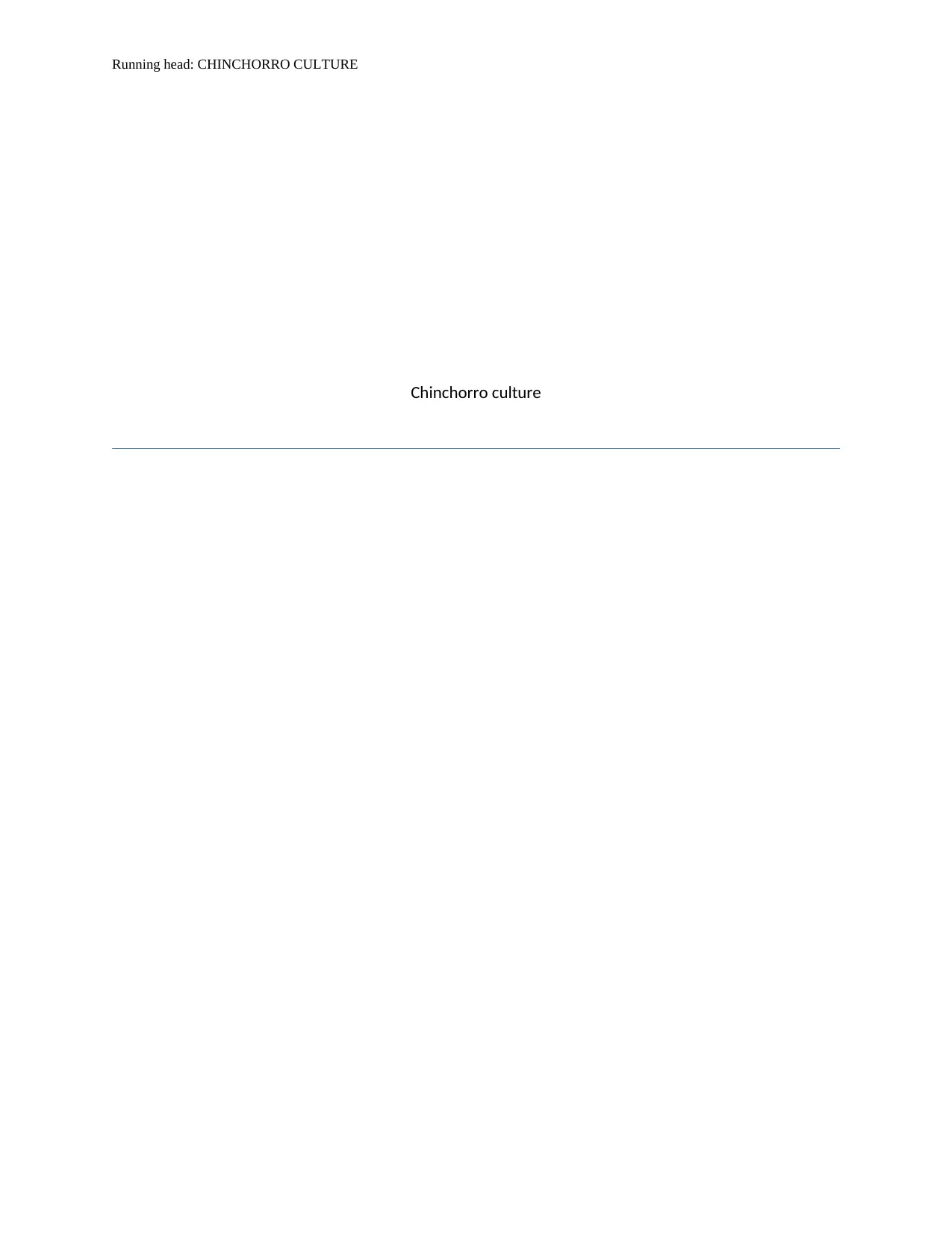
Running head: CHINCHORRO CULTURE
Chinchorro culture
Chinchorro culture
Paraphrase This Document
Need a fresh take? Get an instant paraphrase of this document with our AI Paraphraser
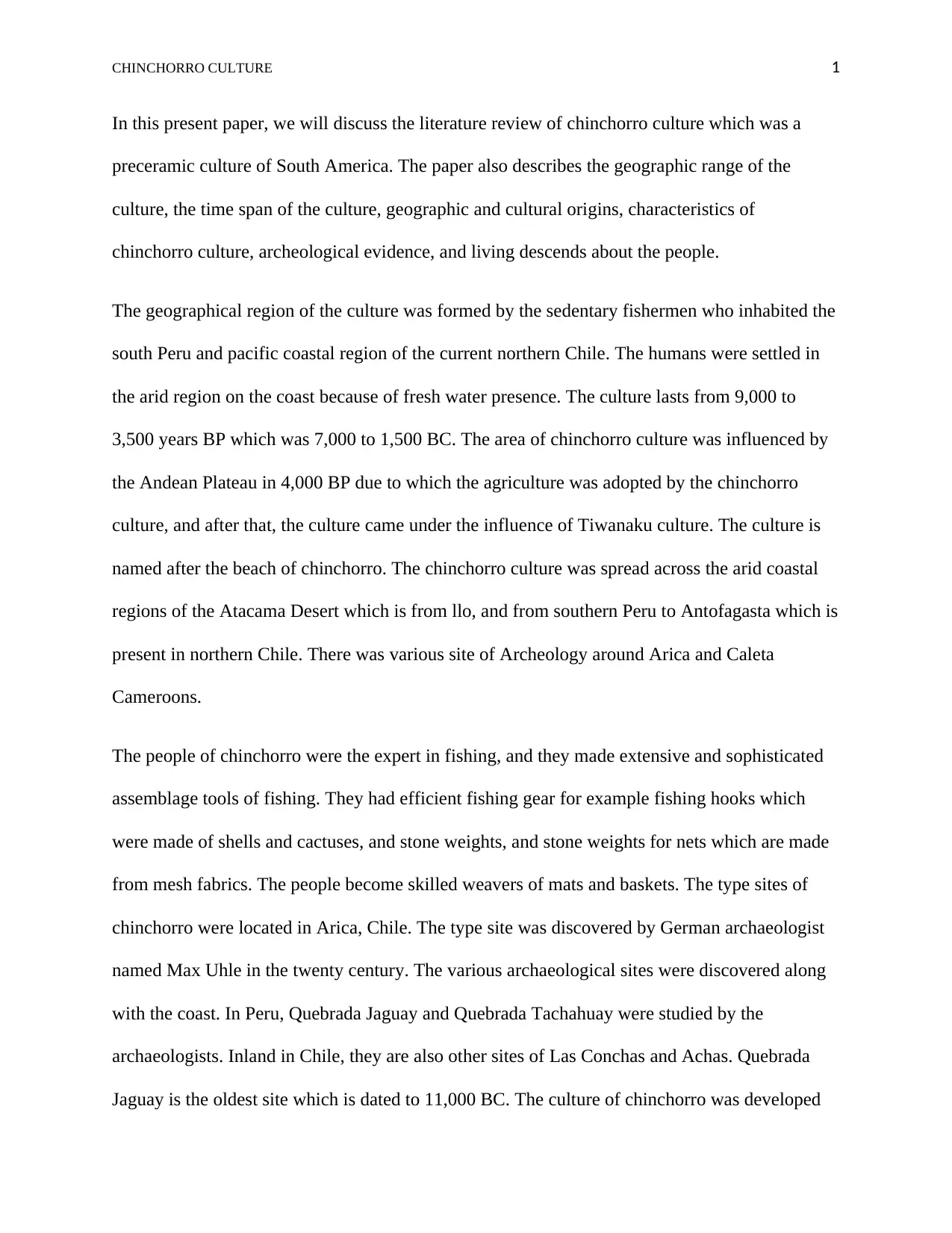
CHINCHORRO CULTURE 1
In this present paper, we will discuss the literature review of chinchorro culture which was a
preceramic culture of South America. The paper also describes the geographic range of the
culture, the time span of the culture, geographic and cultural origins, characteristics of
chinchorro culture, archeological evidence, and living descends about the people.
The geographical region of the culture was formed by the sedentary fishermen who inhabited the
south Peru and pacific coastal region of the current northern Chile. The humans were settled in
the arid region on the coast because of fresh water presence. The culture lasts from 9,000 to
3,500 years BP which was 7,000 to 1,500 BC. The area of chinchorro culture was influenced by
the Andean Plateau in 4,000 BP due to which the agriculture was adopted by the chinchorro
culture, and after that, the culture came under the influence of Tiwanaku culture. The culture is
named after the beach of chinchorro. The chinchorro culture was spread across the arid coastal
regions of the Atacama Desert which is from llo, and from southern Peru to Antofagasta which is
present in northern Chile. There was various site of Archeology around Arica and Caleta
Cameroons.
The people of chinchorro were the expert in fishing, and they made extensive and sophisticated
assemblage tools of fishing. They had efficient fishing gear for example fishing hooks which
were made of shells and cactuses, and stone weights, and stone weights for nets which are made
from mesh fabrics. The people become skilled weavers of mats and baskets. The type sites of
chinchorro were located in Arica, Chile. The type site was discovered by German archaeologist
named Max Uhle in the twenty century. The various archaeological sites were discovered along
with the coast. In Peru, Quebrada Jaguay and Quebrada Tachahuay were studied by the
archaeologists. Inland in Chile, they are also other sites of Las Conchas and Achas. Quebrada
Jaguay is the oldest site which is dated to 11,000 BC. The culture of chinchorro was developed
In this present paper, we will discuss the literature review of chinchorro culture which was a
preceramic culture of South America. The paper also describes the geographic range of the
culture, the time span of the culture, geographic and cultural origins, characteristics of
chinchorro culture, archeological evidence, and living descends about the people.
The geographical region of the culture was formed by the sedentary fishermen who inhabited the
south Peru and pacific coastal region of the current northern Chile. The humans were settled in
the arid region on the coast because of fresh water presence. The culture lasts from 9,000 to
3,500 years BP which was 7,000 to 1,500 BC. The area of chinchorro culture was influenced by
the Andean Plateau in 4,000 BP due to which the agriculture was adopted by the chinchorro
culture, and after that, the culture came under the influence of Tiwanaku culture. The culture is
named after the beach of chinchorro. The chinchorro culture was spread across the arid coastal
regions of the Atacama Desert which is from llo, and from southern Peru to Antofagasta which is
present in northern Chile. There was various site of Archeology around Arica and Caleta
Cameroons.
The people of chinchorro were the expert in fishing, and they made extensive and sophisticated
assemblage tools of fishing. They had efficient fishing gear for example fishing hooks which
were made of shells and cactuses, and stone weights, and stone weights for nets which are made
from mesh fabrics. The people become skilled weavers of mats and baskets. The type sites of
chinchorro were located in Arica, Chile. The type site was discovered by German archaeologist
named Max Uhle in the twenty century. The various archaeological sites were discovered along
with the coast. In Peru, Quebrada Jaguay and Quebrada Tachahuay were studied by the
archaeologists. Inland in Chile, they are also other sites of Las Conchas and Achas. Quebrada
Jaguay is the oldest site which is dated to 11,000 BC. The culture of chinchorro was developed
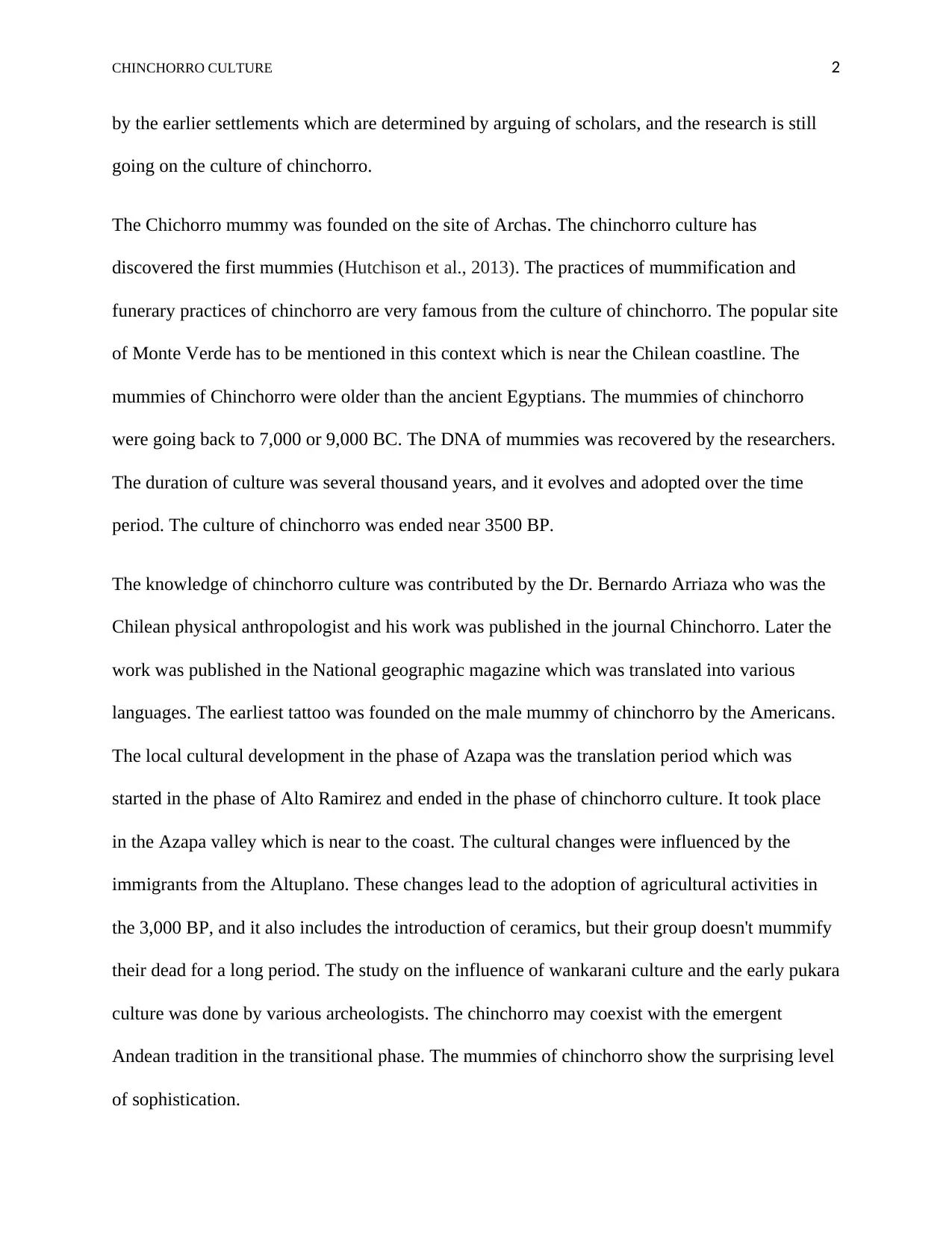
CHINCHORRO CULTURE 2
by the earlier settlements which are determined by arguing of scholars, and the research is still
going on the culture of chinchorro.
The Chichorro mummy was founded on the site of Archas. The chinchorro culture has
discovered the first mummies (Hutchison et al., 2013). The practices of mummification and
funerary practices of chinchorro are very famous from the culture of chinchorro. The popular site
of Monte Verde has to be mentioned in this context which is near the Chilean coastline. The
mummies of Chinchorro were older than the ancient Egyptians. The mummies of chinchorro
were going back to 7,000 or 9,000 BC. The DNA of mummies was recovered by the researchers.
The duration of culture was several thousand years, and it evolves and adopted over the time
period. The culture of chinchorro was ended near 3500 BP.
The knowledge of chinchorro culture was contributed by the Dr. Bernardo Arriaza who was the
Chilean physical anthropologist and his work was published in the journal Chinchorro. Later the
work was published in the National geographic magazine which was translated into various
languages. The earliest tattoo was founded on the male mummy of chinchorro by the Americans.
The local cultural development in the phase of Azapa was the translation period which was
started in the phase of Alto Ramirez and ended in the phase of chinchorro culture. It took place
in the Azapa valley which is near to the coast. The cultural changes were influenced by the
immigrants from the Altuplano. These changes lead to the adoption of agricultural activities in
the 3,000 BP, and it also includes the introduction of ceramics, but their group doesn't mummify
their dead for a long period. The study on the influence of wankarani culture and the early pukara
culture was done by various archeologists. The chinchorro may coexist with the emergent
Andean tradition in the transitional phase. The mummies of chinchorro show the surprising level
of sophistication.
by the earlier settlements which are determined by arguing of scholars, and the research is still
going on the culture of chinchorro.
The Chichorro mummy was founded on the site of Archas. The chinchorro culture has
discovered the first mummies (Hutchison et al., 2013). The practices of mummification and
funerary practices of chinchorro are very famous from the culture of chinchorro. The popular site
of Monte Verde has to be mentioned in this context which is near the Chilean coastline. The
mummies of Chinchorro were older than the ancient Egyptians. The mummies of chinchorro
were going back to 7,000 or 9,000 BC. The DNA of mummies was recovered by the researchers.
The duration of culture was several thousand years, and it evolves and adopted over the time
period. The culture of chinchorro was ended near 3500 BP.
The knowledge of chinchorro culture was contributed by the Dr. Bernardo Arriaza who was the
Chilean physical anthropologist and his work was published in the journal Chinchorro. Later the
work was published in the National geographic magazine which was translated into various
languages. The earliest tattoo was founded on the male mummy of chinchorro by the Americans.
The local cultural development in the phase of Azapa was the translation period which was
started in the phase of Alto Ramirez and ended in the phase of chinchorro culture. It took place
in the Azapa valley which is near to the coast. The cultural changes were influenced by the
immigrants from the Altuplano. These changes lead to the adoption of agricultural activities in
the 3,000 BP, and it also includes the introduction of ceramics, but their group doesn't mummify
their dead for a long period. The study on the influence of wankarani culture and the early pukara
culture was done by various archeologists. The chinchorro may coexist with the emergent
Andean tradition in the transitional phase. The mummies of chinchorro show the surprising level
of sophistication.
⊘ This is a preview!⊘
Do you want full access?
Subscribe today to unlock all pages.

Trusted by 1+ million students worldwide
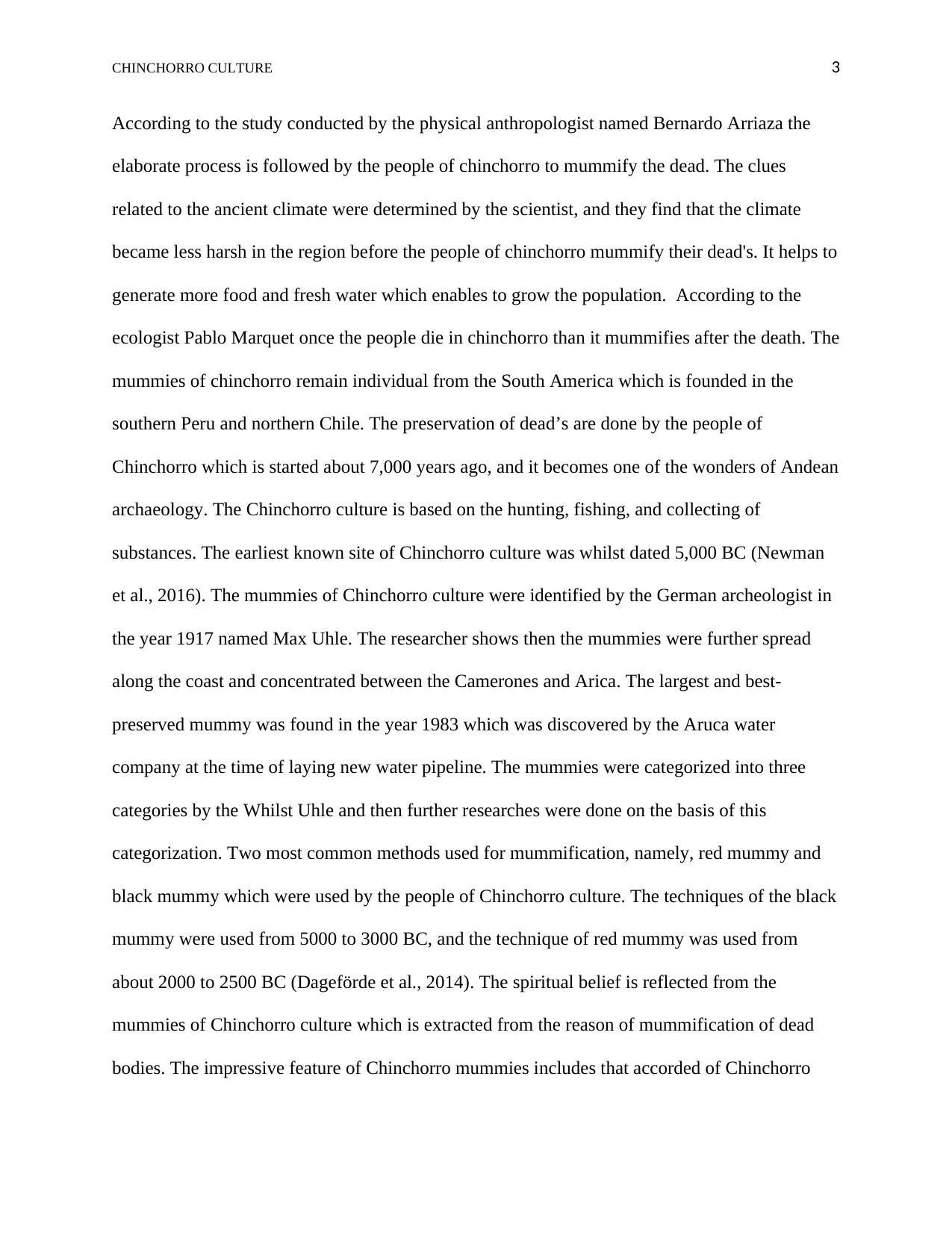
CHINCHORRO CULTURE 3
According to the study conducted by the physical anthropologist named Bernardo Arriaza the
elaborate process is followed by the people of chinchorro to mummify the dead. The clues
related to the ancient climate were determined by the scientist, and they find that the climate
became less harsh in the region before the people of chinchorro mummify their dead's. It helps to
generate more food and fresh water which enables to grow the population. According to the
ecologist Pablo Marquet once the people die in chinchorro than it mummifies after the death. The
mummies of chinchorro remain individual from the South America which is founded in the
southern Peru and northern Chile. The preservation of dead’s are done by the people of
Chinchorro which is started about 7,000 years ago, and it becomes one of the wonders of Andean
archaeology. The Chinchorro culture is based on the hunting, fishing, and collecting of
substances. The earliest known site of Chinchorro culture was whilst dated 5,000 BC (Newman
et al., 2016). The mummies of Chinchorro culture were identified by the German archeologist in
the year 1917 named Max Uhle. The researcher shows then the mummies were further spread
along the coast and concentrated between the Camerones and Arica. The largest and best-
preserved mummy was found in the year 1983 which was discovered by the Aruca water
company at the time of laying new water pipeline. The mummies were categorized into three
categories by the Whilst Uhle and then further researches were done on the basis of this
categorization. Two most common methods used for mummification, namely, red mummy and
black mummy which were used by the people of Chinchorro culture. The techniques of the black
mummy were used from 5000 to 3000 BC, and the technique of red mummy was used from
about 2000 to 2500 BC (Dageförde et al., 2014). The spiritual belief is reflected from the
mummies of Chinchorro culture which is extracted from the reason of mummification of dead
bodies. The impressive feature of Chinchorro mummies includes that accorded of Chinchorro
According to the study conducted by the physical anthropologist named Bernardo Arriaza the
elaborate process is followed by the people of chinchorro to mummify the dead. The clues
related to the ancient climate were determined by the scientist, and they find that the climate
became less harsh in the region before the people of chinchorro mummify their dead's. It helps to
generate more food and fresh water which enables to grow the population. According to the
ecologist Pablo Marquet once the people die in chinchorro than it mummifies after the death. The
mummies of chinchorro remain individual from the South America which is founded in the
southern Peru and northern Chile. The preservation of dead’s are done by the people of
Chinchorro which is started about 7,000 years ago, and it becomes one of the wonders of Andean
archaeology. The Chinchorro culture is based on the hunting, fishing, and collecting of
substances. The earliest known site of Chinchorro culture was whilst dated 5,000 BC (Newman
et al., 2016). The mummies of Chinchorro culture were identified by the German archeologist in
the year 1917 named Max Uhle. The researcher shows then the mummies were further spread
along the coast and concentrated between the Camerones and Arica. The largest and best-
preserved mummy was found in the year 1983 which was discovered by the Aruca water
company at the time of laying new water pipeline. The mummies were categorized into three
categories by the Whilst Uhle and then further researches were done on the basis of this
categorization. Two most common methods used for mummification, namely, red mummy and
black mummy which were used by the people of Chinchorro culture. The techniques of the black
mummy were used from 5000 to 3000 BC, and the technique of red mummy was used from
about 2000 to 2500 BC (Dageförde et al., 2014). The spiritual belief is reflected from the
mummies of Chinchorro culture which is extracted from the reason of mummification of dead
bodies. The impressive feature of Chinchorro mummies includes that accorded of Chinchorro
Paraphrase This Document
Need a fresh take? Get an instant paraphrase of this document with our AI Paraphraser
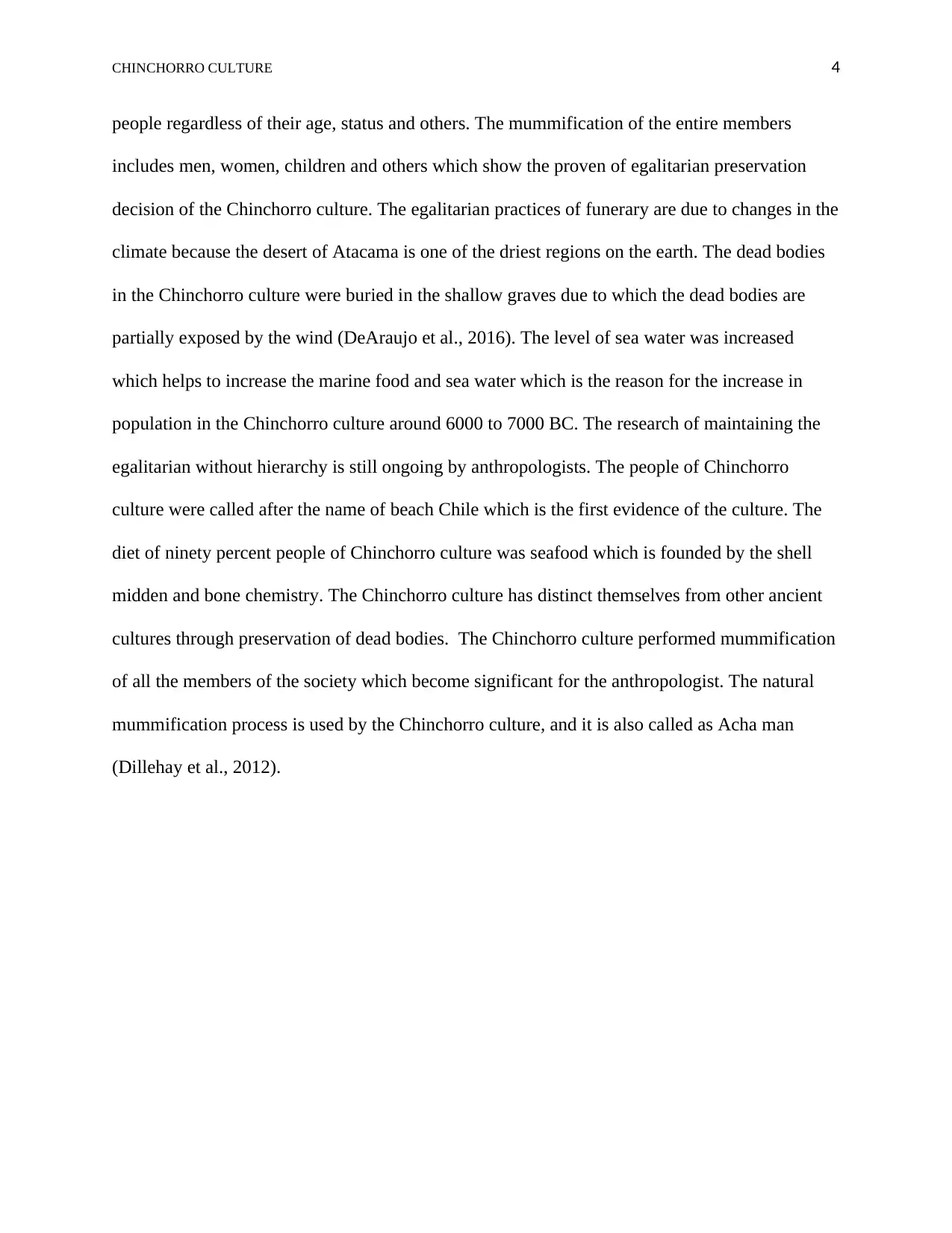
CHINCHORRO CULTURE 4
people regardless of their age, status and others. The mummification of the entire members
includes men, women, children and others which show the proven of egalitarian preservation
decision of the Chinchorro culture. The egalitarian practices of funerary are due to changes in the
climate because the desert of Atacama is one of the driest regions on the earth. The dead bodies
in the Chinchorro culture were buried in the shallow graves due to which the dead bodies are
partially exposed by the wind (DeAraujo et al., 2016). The level of sea water was increased
which helps to increase the marine food and sea water which is the reason for the increase in
population in the Chinchorro culture around 6000 to 7000 BC. The research of maintaining the
egalitarian without hierarchy is still ongoing by anthropologists. The people of Chinchorro
culture were called after the name of beach Chile which is the first evidence of the culture. The
diet of ninety percent people of Chinchorro culture was seafood which is founded by the shell
midden and bone chemistry. The Chinchorro culture has distinct themselves from other ancient
cultures through preservation of dead bodies. The Chinchorro culture performed mummification
of all the members of the society which become significant for the anthropologist. The natural
mummification process is used by the Chinchorro culture, and it is also called as Acha man
(Dillehay et al., 2012).
people regardless of their age, status and others. The mummification of the entire members
includes men, women, children and others which show the proven of egalitarian preservation
decision of the Chinchorro culture. The egalitarian practices of funerary are due to changes in the
climate because the desert of Atacama is one of the driest regions on the earth. The dead bodies
in the Chinchorro culture were buried in the shallow graves due to which the dead bodies are
partially exposed by the wind (DeAraujo et al., 2016). The level of sea water was increased
which helps to increase the marine food and sea water which is the reason for the increase in
population in the Chinchorro culture around 6000 to 7000 BC. The research of maintaining the
egalitarian without hierarchy is still ongoing by anthropologists. The people of Chinchorro
culture were called after the name of beach Chile which is the first evidence of the culture. The
diet of ninety percent people of Chinchorro culture was seafood which is founded by the shell
midden and bone chemistry. The Chinchorro culture has distinct themselves from other ancient
cultures through preservation of dead bodies. The Chinchorro culture performed mummification
of all the members of the society which become significant for the anthropologist. The natural
mummification process is used by the Chinchorro culture, and it is also called as Acha man
(Dillehay et al., 2012).
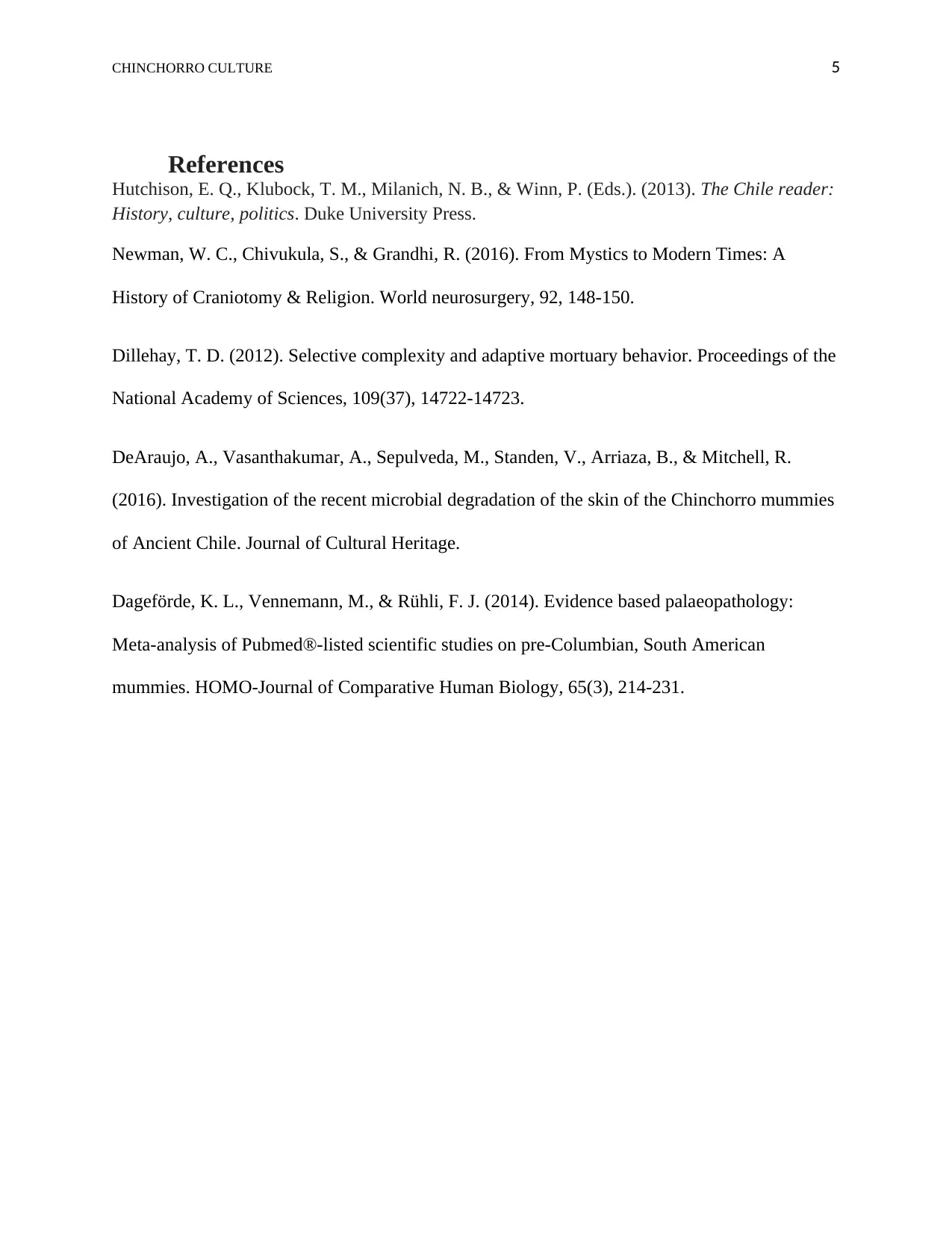
CHINCHORRO CULTURE 5
References
Hutchison, E. Q., Klubock, T. M., Milanich, N. B., & Winn, P. (Eds.). (2013). The Chile reader:
History, culture, politics. Duke University Press.
Newman, W. C., Chivukula, S., & Grandhi, R. (2016). From Mystics to Modern Times: A
History of Craniotomy & Religion. World neurosurgery, 92, 148-150.
Dillehay, T. D. (2012). Selective complexity and adaptive mortuary behavior. Proceedings of the
National Academy of Sciences, 109(37), 14722-14723.
DeAraujo, A., Vasanthakumar, A., Sepulveda, M., Standen, V., Arriaza, B., & Mitchell, R.
(2016). Investigation of the recent microbial degradation of the skin of the Chinchorro mummies
of Ancient Chile. Journal of Cultural Heritage.
Dageförde, K. L., Vennemann, M., & Rühli, F. J. (2014). Evidence based palaeopathology:
Meta-analysis of Pubmed®-listed scientific studies on pre-Columbian, South American
mummies. HOMO-Journal of Comparative Human Biology, 65(3), 214-231.
References
Hutchison, E. Q., Klubock, T. M., Milanich, N. B., & Winn, P. (Eds.). (2013). The Chile reader:
History, culture, politics. Duke University Press.
Newman, W. C., Chivukula, S., & Grandhi, R. (2016). From Mystics to Modern Times: A
History of Craniotomy & Religion. World neurosurgery, 92, 148-150.
Dillehay, T. D. (2012). Selective complexity and adaptive mortuary behavior. Proceedings of the
National Academy of Sciences, 109(37), 14722-14723.
DeAraujo, A., Vasanthakumar, A., Sepulveda, M., Standen, V., Arriaza, B., & Mitchell, R.
(2016). Investigation of the recent microbial degradation of the skin of the Chinchorro mummies
of Ancient Chile. Journal of Cultural Heritage.
Dageförde, K. L., Vennemann, M., & Rühli, F. J. (2014). Evidence based palaeopathology:
Meta-analysis of Pubmed®-listed scientific studies on pre-Columbian, South American
mummies. HOMO-Journal of Comparative Human Biology, 65(3), 214-231.
⊘ This is a preview!⊘
Do you want full access?
Subscribe today to unlock all pages.

Trusted by 1+ million students worldwide
1 out of 6
Your All-in-One AI-Powered Toolkit for Academic Success.
+13062052269
info@desklib.com
Available 24*7 on WhatsApp / Email
![[object Object]](/_next/static/media/star-bottom.7253800d.svg)
Unlock your academic potential
© 2024 | Zucol Services PVT LTD | All rights reserved.